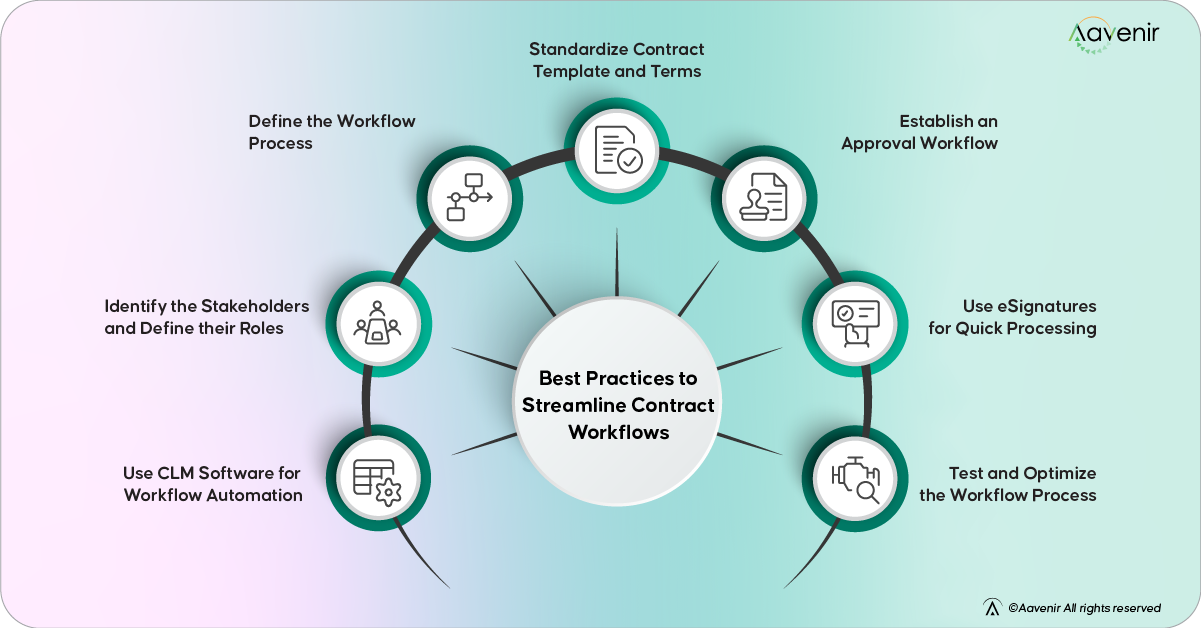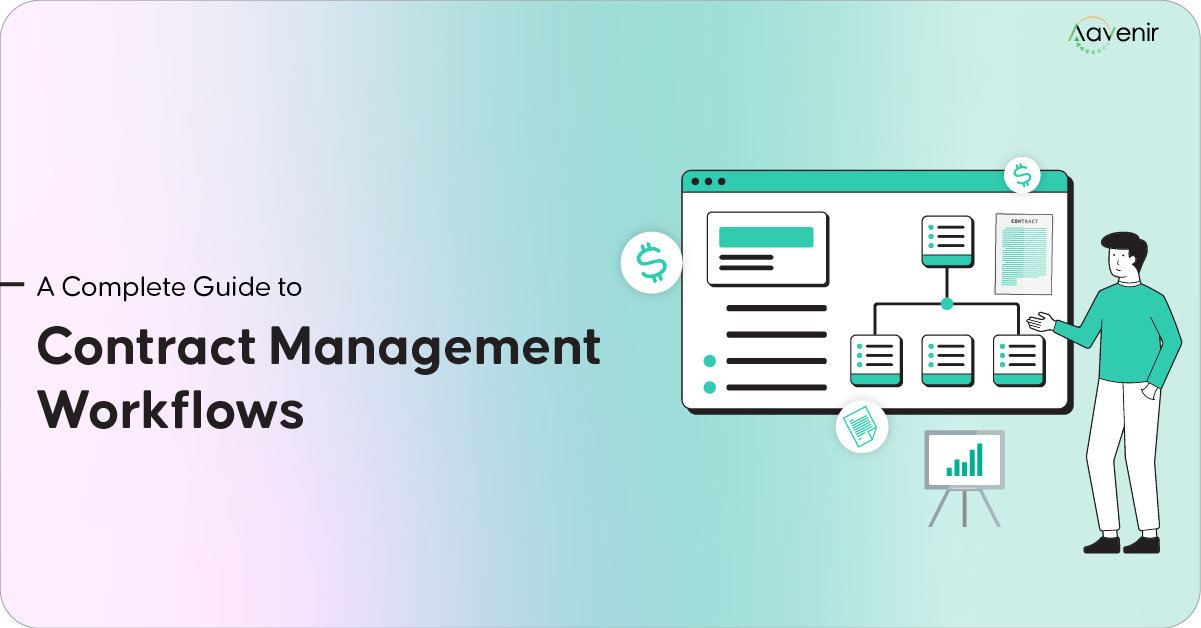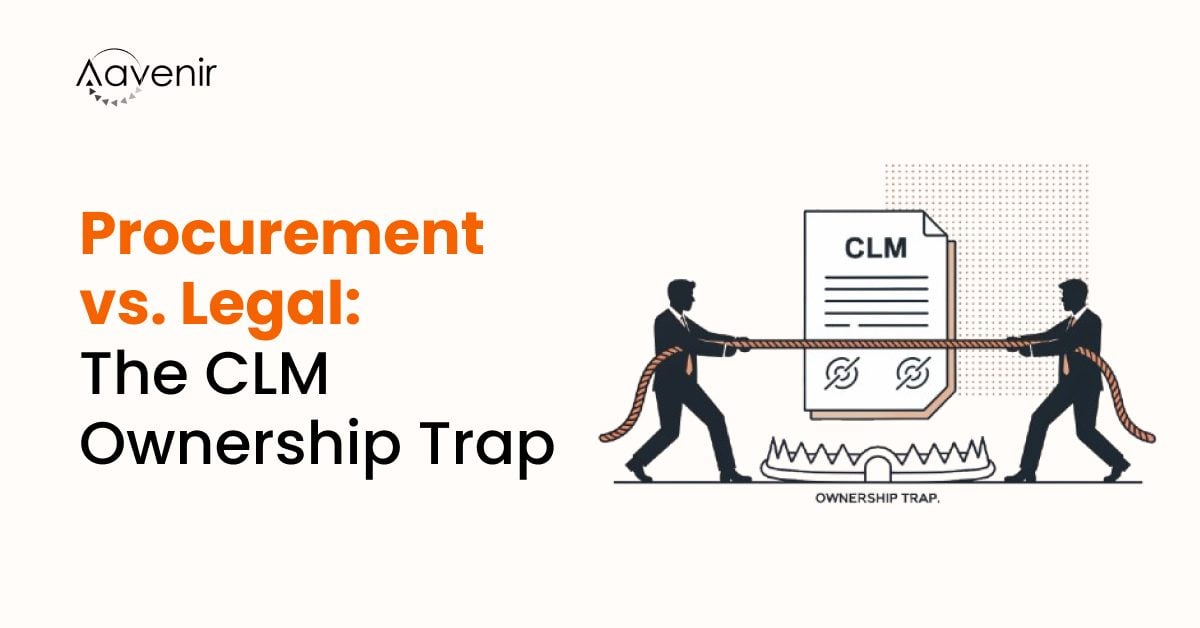Are you struggling with never-ending email chains, missed deadlines, and scattered contracts? Many organizations face these challenges in managing their contracts, often resulting in missed deadlines, chaotic workflows, and overlooked renewals.
As per KPMG International, businesses can lose as much as 40% of a contract’s value due to inefficiencies in contract management processes. A well-structured contract management workflow can turn this chaos into order, ensuring every agreement is tracked, reviewed, and executed seamlessly.
Whether you’re managing hundreds or thousands of contracts, client agreements, vendor contracts, or procurement deals, our comprehensive guide will empower you to build a robust contract workflow tailored to your organization’s needs. Let’s get started.
What is a Contract Management Workflow?
A contract workflow is a structured process that a contract follows throughout its lifecycle—from creation and review to execution and tracking. It defines the key stages and actions needed to efficiently draft, review, approve, and finalize agreements.
You can define workflows for each step of the process—from authoring to negotiation and approvals to execution and renewal or termination. The entire contract workflow requires coordinating the stages with multiple stakeholders. These stakeholders can belong to different work areas like legal, sales, procurement, operations, compliance, and finance.
To manage contract workflows, you must clearly understand the different stages involved in the contract lifecycle. Additionally, pay attention to the roles and responsibilities of the stakeholders involved.
Pro Tip: Use CLM software like Aavenir to streamline all your contract-related tasks and reduce manual errors. It will also help you ensure compliance with legal and regulatory requirements.
Now that you understand contract workflows, let’s examine the essential steps involved in building and managing an effective contract management workflow process.
What are the Essential Steps of Contract Workflow?

A well-defined contract workflow ensures that every contract moves smoothly from creation to completion without delays or confusion. Here are the steps that structure an effective contract management workflow process:
1. Contract Request and Intake
The first step of the contract lifecycle management process is to request a contract. This initial step comprises identifying the parties involved, outlining the scope of work, and mentioning payment terms and other relevant terms and conditions. If you have any existing contract templates, you can use them to draft contracts instead of creating them from scratch.
2. Contract Drafting
After the contract request is approved, contract writers prepare the first draft based on the information provided. Contract management workflow automation can help automate the creation of contracts, such as NDAs and other agreements.
3. Contract Review
Once the contract is drafted, it is circulated among stakeholders from departments like legal, finance, operations, and compliance for a thorough review. This step ensures that the contract aligns with the organization’s specific objectives, meets stakeholders’ interests, and adheres to applicable laws and regulations.
4. Contract Negotiation
Stakeholders and parties involved discuss and modify the contract terms to reach a mutually beneficial agreement. An effective contract negotiation balances the interests of both the organization and the counterparty, ensuring a fair, favorable, and enforceable contract.
5. Contract Approval & Execution
After all parties agree on the decided terms, the finalized contract is recirculated to relevant stakeholders for final approval and signature. Most of the organizations include their legal team in the final review. After approval, the contract proceeds to the execution stage, where authorized representatives formally sign the document, making it legally binding.
6. Contract Storage
The executed contract is stored in a centralized repository, offering easy access and retrieval. Using advanced contract management software, such as Aavenir’s AI-powered contract repository software, ensures secure storage while facilitating ongoing monitoring and management throughout the contract’s lifecycle.
7. Obligation & Compliance Management
Managing contractual obligations and ensuring compliance are important aspects of effective contract management. Utilizing specialized contractual obligation software can enhance this entire process. CLM tools like Aavenir assist in auto-tracking obligations, mitigating risks, avoiding potential disputes, and maintaining business relationships.
8. Audit & Reporting
Regular audits and reports will give detailed insights into contract performance and compliance. This step helps identify areas for improvement, track contract management KPIs, and ensure transparency and accountability in contract management processes.
9. Amendments
Modifications may be necessary during the contract’s lifecycle due to changing business objectives and legal frameworks. A structured amendment process ensures that all changes are documented, agreed upon, and compliant with original contract terms.
10. Contract Renewal or Termination
As the contract is about to end, one must decide whether to renew or terminate the agreement. This step must be managed proactively to ensure that renewals are negotiated promptly or terminations are handled smoothly, maintaining business continuity.
No More Missed Deadlines or Compliance Gaps
Use Aavenir to automate reminders, track renewals, and manage contracts proactively across departments.
A clear contract workflow ensures every contract moves smoothly from request to execution and beyond, minimizing risks and delays. Once these steps are in place, let’s explore the top benefits businesses can experience by optimizing their contract workflows.
Top 5 Benefits of Optimized Contract Workflows
Optimizing your contract management workflow can transform how your business handles agreements. Below are the top five benefits you can expect from a well-structured workflow:
1. Eliminates Bottlenecks
A well-structured contract workflow reduces manual errors and ensures each stage of the contract lifecycle, ranging from creation and approval to monitoring progress. Organizations can avoid confusion and delays by clearly defining roles, responsibilities, and processes. This clarity allows teams to focus on strategic activities that drive business growth.
2. Speeds Up Contract Creation
Utilizing manual processes leads to inefficiencies, from finding stakeholders to updating spreadsheets. An optimized contract management workflow overtakes these repetitive tasks.
This ensures that each party involved knows their responsibilities at each step. Additionally, it lessens delays, reduces human errors, and helps your team focus on important initiatives rather than being tangled in administrative work.
3. Improves Contract Turnaround Time
Contract TAT is one of the most important factors in closing a deal. Organizations can reduce the time required to prepare, review, and approve contracts by automating contract management workflows.
This time-saving approach ensures that contracts are sent to the appropriate stakeholders for review and approval. Last but not least, it also helps the sales team close deals quickly while improving their overall productivity.
4. Reduces Operational Costs
Streamlined workflows decrease the dependency on manual labor, significantly reducing administrative expenses. Contract management tools reduce the need for extensive human intervention in routine tasks, lowering labor costs. Additionally, minimizing errors and delays through automation contributes to cost savings and improves overall resource allocation.
5. Enhances Contract Compliance
Contracts are the very foundation of a business relationship. Any mistake in tracking contract obligations and compliance could lead to financial penalties or legal disputes. Preparing a robust contract management workflow ensures the use of pre-approved clauses, proper documentation, and thorough reviews. This structured process helps organizations maintain compliance and reduces the risk of errors that could impact business operations.
While optimized workflows bring speed and efficiency, many businesses still face hurdles. Here are the most common contract workflow challenges.
What are the 5 Common Contract Workflow Challenges?
Effective contract management workflow management is crucial for organizational success, yet several common challenges can hinder this process. These challenges are:
1. Manual and Inefficient Processes
Using traditional contract management methods like spreadsheets and email might lead to errors, delays, and increased administrative burdens. These manual processes often result in miscommunication among stakeholders, affecting the efficiency of contract management.
2. Lack of Standardization
The absence of standardized templates and clauses results in inconsistency in contract language, leading to misunderstandings and increased legal risks. It also becomes difficult to enforce terms consistently, complicating the contract review and approval process.
3. Poor Visibility and Tracking
Contracts are often stored across various departments, making them hard to track. Without a centralized system, monitoring key terms, obligations, and deadlines becomes challenging, increasing the risk of missed opportunities. This poor visibility might lead to unintentional renewals or expirations, affecting business relationships and financial outcomes.
4. Compliance and Legal Risks
Inadequate monitoring of contractual obligations might result in non-compliance and legal disputes, harming the organization’s reputation. Organizations must ensure that all contracts fulfill legal and regulatory requirements. Doing so will help you avoid breaches and the associated consequences.
5. Lack of Integration with Other Business Systems
Disconnected business apps like CRM, HRMS, and ERPs lead to bottlenecks in contract workflows. Without seamless integration and proper communication among the departments, there are higher chances of duplicate data entry and miscommunication, making it harder to manage contracts efficiently across departments.
Streamline Contract Workflows with Aavenir
Leverage Aavenir’s AI-driven automation to simplify contract creation, approval, and compliance management.
Now that you know the key challenges in contractual workflows, let’s explore best practices to overcome them and streamline your contract workflows.
8 Best Practices to Streamline Contract Workflows

Streamlining contract workflows is essential for enhancing efficiency, reducing errors, and ensuring compliance within an organization. Here are eight best practices to optimize your contract management processes:
1. Use CLM Software for Workflow Automation
Implementing CLM software automates repetitive tasks, reduces manual errors, and accelerates the contract lifecycle. Contract management workflow automation ensures that contracts move seamlessly through each stage, from creation to execution. With solutions like Aavenir CLM, you also gain the advantage of AI-based contract data extraction, automated obligation tracking, and customized approval workflows.
2. Identify the Stakeholders and Define their Roles
Before creating a contract workflow, you must recognize the stakeholders involved in the entire contract management process. Once done, ensure to define their specific roles and responsibilities to avoid any confusion and delays.
Here are some questions you need to answer:
- Who holds ownership of the contract templates?
- Who is responsible for creating contracts using those templates?
- Who approves contracts before their distribution?
- Who handles the negotiation of contracts?
- Who is authorized to sign contracts?
- Who manages contract tracking and oversees renewals?
Clearly defining these roles and responsibilities will help prevent contracts from being sent to the wrong team or function, avoiding delays in the process. Once these roles are assigned, you can move on to the next step in establishing an efficient contract workflow.
3. Define the Workflow Process
After identifying the stakeholders, it is time to map out the entire contract workflow from creation to termination. This involves detailing every stage of the entire process and the associated tasks. A well-designed workflow eliminates inefficiencies and bottlenecks, enabling targeted improvements.
The key stages of a contract workflow include drafting, review, approval, execution through electronic signatures, performance monitoring, amendments, and renewals/terminations. Mapping out the stages will provide a clear roadmap and ensure every phase is handled systematically and efficiently.
4. Standardize Contract Template and Terms
Ensure standardized contract templates and terms for maintaining consistency and accuracy in contract creation. Having a pre-defined template enables organizations to create contracts quickly while ensuring all necessary terms are included.
You can create your customized template or opt for contract authoring software to help you create the same. With Aavenir, you can easily create a contract without worrying about contacting an external stakeholder.
After standardizing contract templates, it is time to define clauses to be added to the contract when needed. Defining contract templates and clauses streamlines contract creation, minimizes errors, and ensures compliance with legal requirements and best practices.
5. Establish an Approval Workflow
Implementing a clear approval workflow is critical to ensuring that every contract is thoroughly vetted before finalization. This structured approach minimizes delays and maintains compliance with organizational policies.
Key elements of an approval workflow are:
- Clear Approval Steps: Establish a clear sequence of approvals needed, from the initial draft to final sign-off.
- Role-Based Access: Ensure only authorized individuals can approve specific contract types according to their roles and responsibilities.
- Automated Notifications: Set up systems that automatically alert stakeholders when their approval is required, minimizing delays and ensuring timely processing.
By setting up an approval workflow, you can ensure that all necessary parties review and approve the contract before it is finalized.
6. Use eSignatures for Quick Processing
The most time-consuming aspect of contract management is getting contracts signed by all the parties. Traditional contract signing methods like fax and email are slow and prone to errors and delays. To avoid these issues, opt for Electronic signatures (eSignatures).
Advantages of eSignatures:
- Speed: Sign and execute contracts within minutes rather than days or weeks.
- Convenience: Parties can sign documents from anywhere, eliminating the need for physical presence.
- Security: eSignatures provide enhanced security features, such as audit trails ensuring the integrity of the signed documents.
- Cost Savings: Reduces the costs associated with printing, mailing, and storing physical documents.
Using eSignatures in the contract workflow speeds up the signing process and enhances overall efficiency. By terminating manual signatures, organizations can focus more on strategic tasks and less on administrative burdens.
7. Test and Optimize the Workflow Process
Before implementing the contract workflow process, it is essential to test it thoroughly to identify any issues or inefficiencies that need to be addressed. This helps ensure the workflow process is effective and efficient and meets the business’s needs.
- Conduct a Pilot Test: Select a small group of stakeholders to test the workflow on a limited number of contracts, identifying any issues or errors.
- Get Feedback: Collect input from all pilot test participants to pinpoint areas for improvement and ensure the workflow meets stakeholder needs.
- Make Necessary Adjustments: Based on feedback, adjust the workflow process and templates to enhance efficiency and usability for all stakeholders.
- Conduct a Full-Scale Test: After adjustments, perform a full-scale test of the workflow to uncover any additional issues before system deployment.
- Improve the Workflow Process: Based on full-scale test results, refine the workflow and templates as needed, ensuring all stakeholders are comfortable with the new system and clear on their roles.
8. Train Employees on the Workflow and Software Tools
The last but one of the most important steps is to train employees on the ways to use the contract management software and follow the workflow process. Once you have trained your employees, they will know their roles and responsibilities in the contract management process.
Here are some of the most effective strategies to train your employees as listed below:
- Create a Training Plan: Develop a training plan that focuses on the training objectives, covered topics, and training timeline.
- Use Multiple Training Methods: Use different training methods such as online tutorials, classroom training, and one-on-one coaching.
- Offer Hands-on Training: Allow your employees to practice using the software in a real-world setting to become proficient in it.
- Provide Ongoing Support: Ensure that your employees have access to ongoing support and resources, such as user manuals and online forums.
Accelerate Contract Approvals with Aavenir
See how Aavenir’s customizable workflows and eSignature integration help speed up contract processes and reduce bottlenecks.
By following these best practices, businesses can significantly improve efficiency and accuracy. Now, let’s see how Aavenir can help optimize your contract management workflow.
Speed Up Your CLM Cycles by 80% With Aavenir
It is important to choose the right CLM platform to streamline your contract management workflow. Aavenir is one of the best contract lifecycle management solutions designed to simplify and automate each stage of your contract management workflow—creation, review, approval, execution, tracking, and renewal.
Aavenir’s AI-powered contract intelligence solution automates reminders and improves real-time collaboration—helping eliminate manual errors and accelerate contract cycles. Notably, according to Gartner Peer Insights, Aavenir Contractflow has received positive feedback, with a 4.7 out of 5 rating in Service & Support and a 4.3 in Integration & Deployment.
Whether you’re managing a handful of contracts or scaling to thousands, Aavenir makes the process more transparent, compliant, and efficient, helping businesses get 5X better visibility over contracts. To learn more about Aavenir’s capabilities, book a demo and transform your contract management processes.
Frequently Asked Questions
1. How can businesses measure the success of their contract management workflow?
Businesses can measure success by tracking contract approval times, compliance rates, and renewal efficiency. Monitoring error reduction, cost savings from automation, and fewer manual tasks indicate a well-optimized workflow. These metrics highlight both strengths and areas for improvement.
2. How do contract workflows differ for small businesses versus enterprises?
Small businesses are dependent on manual contract workflows like spreadsheets and email-based approvals. These manual contract management processes lead to inefficiencies and missed deadlines.
Enterprises need CLM systems to handle high volumes of contracts. These systems must also have features like workflow automation, AI-driven analytics, and integration with ERP and CRM platforms.
3. What are the most overlooked risks in contract workflows?
One of the most overlooked risks in contract workflow is poor version control, leading to outdated or conflicting agreements being signed. Additionally, the lack of standardized contract templates increases the risk of non-compliance with legal and regulatory standards. Last but not least, any missed deadline might result in lost revenue and unnecessary contract extensions.
4. How do industry regulations impact contract workflows?
Each industry has its specific compliance requirements that must be embedded within contract workflows. For example, healthcare contracts must comply with HIPAA regulations, while financial services contracts need to meet SOX (Sarbanes-Oxley Act) compliance.
Similarly, contracts that involve personal data must adhere to GDPR or CCPA requirements. Automated compliance tracking, audit trails, and AI-powered risk assessments help businesses stay compliant with industry regulations.
5. Can contract workflows integrate with existing CRM and ERP systems?
Yes, modern contract management software integrates seamlessly with Salesforce, SAP, Oracle, and HubSpot, ensuring a smooth flow of contract data between departments. These third-party integrations help align sales contracts with customer records and synchronize procurement contracts with supplier databases. Last but not least, real-time updates help businesses reduce manual data entry and improve contract tracking across different systems.



